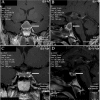Pituitary Adenoma Apoplexy in an Adolescent: A Case Report and Review of the Literature
- PMID: 28588003
- PMCID: PMC5596809
- DOI: 10.4274/jcrpe.4420
Pituitary Adenoma Apoplexy in an Adolescent: A Case Report and Review of the Literature
Abstract
We present a 13-year-old boy who was admitted with complaints of a state of progressive sleepiness and a sudden headache with vomiting and fever. Laboratory testing showed hypoglycemia, multiple pituitary hormonal deficiencies, and an elevated C-reactive protein level. A cranial magnetic resonance imaging (MRI) showed an opaque sphenoid sinus and an intrasellar mass suggesting hemorrhage, so that we suspected pituitary apoplexy (PA) originating from a non-functioning adenoma, although a pituitary abscess could not completely be excluded. The boy was treated with antibiotics, hydrocortisone, and levothyroxine. Due to his rapid clinical improvement, no surgery was performed and we considered the diagnosis of PA as confirmed. At follow-up, the MRI scan showed a small residual lesion. Pituitary deficiencies of growth hormone, adrenocorticotropic hormone (ACTH), thyroid-stimulating hormone, and vasopressin persisted. A literature search of all well-documented cases of PA in children or adolescents (n=30, 13 boys and 17 girls) indicated that this condition is rare below 20 years of age but must be considered when a patient experiences headache with or without visual disturbances, even in the presence of clinical and laboratory signals suggestive of pituitary abscess. MRI neuroimaging is helpful in the differential diagnosis. In both conditions, the possibility of ACTH deficiency should always be considered, investigated, and treated. In cases without severe neuro-ophthalmological deficits and/or with a rapid and positive response to acute medical management, one can abstain from surgical treatment.
Keywords: Pituitary adenoma; adolescents; apoplexy; headache magnetic resonance imaging.; panhypopituitarism; pituitary abscess.
Figures
Similar articles
-
Spontaneous regression of non-functioning pituitary adenoma due to pituitary apoplexy following anticoagulation treatment - a case report and review of the literature.Endokrynol Pol. 2013;64(1):54-8. Endokrynol Pol. 2013. PMID: 23450448 Review.
-
Pituitary apoplexy in the magnetic resonance imaging era: clinical significance of sphenoid sinus mucosal thickening.J Neurosurg. 2006 Jun;104(6):892-8. doi: 10.3171/jns.2006.104.6.892. J Neurosurg. 2006. PMID: 16776332
-
Gestational pituitary apoplexy: Case series and review of the literature.J Gynecol Obstet Hum Reprod. 2019 Dec;48(10):873-881. doi: 10.1016/j.jogoh.2019.05.005. Epub 2019 May 3. J Gynecol Obstet Hum Reprod. 2019. PMID: 31059861 Review.
-
Management and outcomes of pituitary apoplexy.J Neurosurg. 2015 Jun;122(6):1450-7. doi: 10.3171/2014.10.JNS141204. Epub 2015 Apr 10. J Neurosurg. 2015. PMID: 25859804
-
Sudden headache, third nerve palsy and visual deficit: thinking outside the subarachnoid haemorrhage box.Age Ageing. 2013 Nov;42(6):810-2. doi: 10.1093/ageing/aft088. Epub 2013 Aug 1. Age Ageing. 2013. PMID: 23913476
Cited by
-
Pituitary Apoplexy in a Child with Short Stature and Possible Recent SARS-CoV-2 Infection.Diagnostics (Basel). 2025 Jun 7;15(12):1453. doi: 10.3390/diagnostics15121453. Diagnostics (Basel). 2025. PMID: 40564774 Free PMC article.
-
Transnasal Transsphenoidal Approach for a Nine-Year-Old Child With Pituitary Apoplexy: A Case Report.Cureus. 2024 Jul 14;16(7):e64525. doi: 10.7759/cureus.64525. eCollection 2024 Jul. Cureus. 2024. PMID: 39139339 Free PMC article.
-
[Pituitary apoplexy in pediatric patients: systematic review].Rev Fac Cien Med Univ Nac Cordoba. 2022 Jun 6;79(2):141-145. doi: 10.31053/1853.0605.v79.n2.27984. Rev Fac Cien Med Univ Nac Cordoba. 2022. PMID: 35700475 Free PMC article. Spanish.
References
-
- Mindermann T, Wilson CB. Pediatric pituitary adenomas. Neurosurgery. 1995;36:259–269. - PubMed
-
- Oldfield EH, Merrill MJ. Apoplexy of pituitary adenomas: the perfect storm. J Neurosurg. 2015;122:1444–1449. - PubMed
-
- Briet C, Salenave S, Bonneville JF, Laws ER, Chanson P. Pituitary Apoplexy. Endocr Rev. 2015;36:622–645. - PubMed
-
- Dawson BH, Kothandaram P. Acute massive infarction of pituitary adenomas. A study of five patients. J Neurosurg. 1972;37:275–279. - PubMed
Publication types
MeSH terms
LinkOut - more resources
Full Text Sources
Other Literature Sources
Medical
Research Materials

